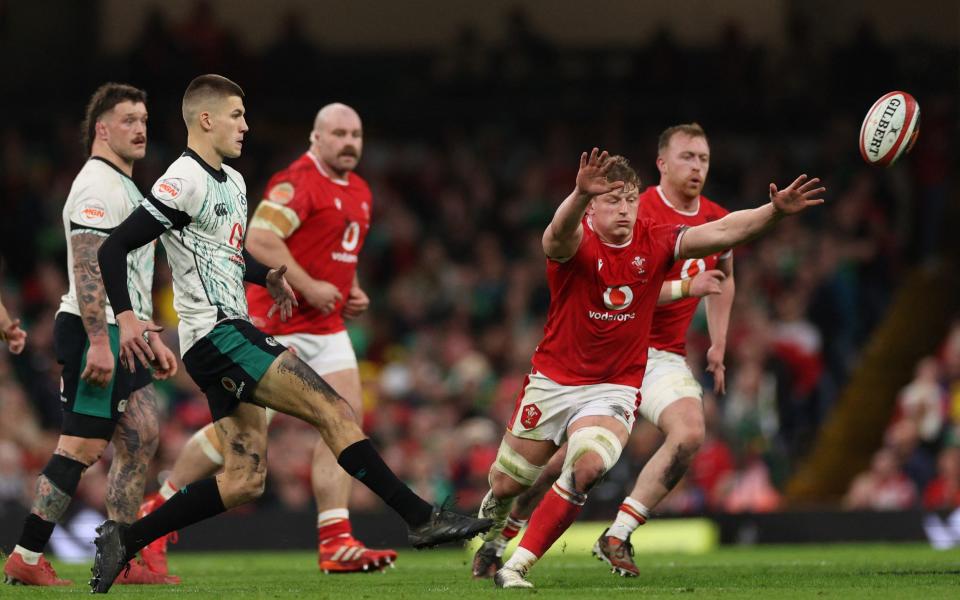
Oh, the spiral is so back.
Sam Prendergast got the purists purring with the moment of the weekend – a 50-22 with so many revs it almost ripped the Principality Stadium turf away like a plaster as it landed in the Welsh half during Ireland’s 27-18 victory. Rugby nerds rejoiced upon seeing that the spiral was alive and well in an end-over-end world.
If that all sounds like gibberish, let me explain. The spiral was once the primary way to kick from hand. To perform one, you hold the ball out in front and – as a right-footed kicker – point the ball just to the left of centre, around 11 o’clock. With your right hand underneath the ball and the left on top, you drop it while keeping your right hand on the belly of the ball for as long as possible.
A long, sweeping leg swing meets the ball a couple of feet from the ground and – if you catch it right – the ball is sent spiralling through the air much like an American football from the arm of a gifted quarterback.
Up until the turn of the century, the end-over-end kick only really came out when a kicker was looking to hoist an up-and-under, or Garryowen. But something sad happened in those early noughties. Pragmatism darkened rugby’s door and the end-over-end kick went mainstream. It was considered more reliable, which in fairness it is. And it was seen as more accurate, which, again, it is. But what you sacrifice is distance.
The longest kick out of hand so far in this Six Nations was one of Prendergast’s against Scotland at 57.6 metres – and it was a spiral. Not only that, the speed the ball travels from a spiral is vastly greater than an end-over-end kick.
It picks up speed as it drops too, and in a world where 50-22s are being chased, the ability to cut off a winger or full-back [or Jarrod Evans, as Prendergast managed against Wales] is increased massively if the kicker opts for the spiral.
There are also the aesthetics of it all. It just looks gorgeous. When you catch a spiral just right, it feels like the 280-yard drive down the middle of the fairway on the first. And there is no better place to watch it than from whence it came. As a kicker, you know if you have nailed it.
Picking your head up to see a tight screw, the ball initially drifting to the left, then tailing off to the right – pure poetry.
When I play for Portsmouth RFC, it is still my go-to in the right circumstances. But shamefully, although I do hit two or three a game, the end-over-end equates to around 90 per cent of my kicks. That’s because a spiral kick has lots of moving parts, the ball-drop has to be just right, so does your hand placement, the angle of the ball and the subsequent angle of your leg following through, and the hardness of your foot.
If anything is slightly off, the whole kick collapses and a shanked spiral can be disastrous – either sailing miles from where you intended it to go, or even travelling just 10 metres. So you need a bit of time to get the nuts and bolts right, which the pesky opposition do not always afford you.
I am so glad the spiral kick is back in the charts, though, because for years it has been on the decline. Back in the mid-2000s, when it was being phased out, I was a season-ticket holder down at the Ospreys – a spiralling hotbed. You had Lee Byrne hitting missiles off his left peg and Gavin Henson sending balls into orbit with his right. But the best exponent of the spiral kick I have ever had the pleasure of watching was Shaun Connor.

Small in stature at 5ft 8in, he had the ball on a string. And the thud of his boots on that Magners League Gilbert match ball was something else.
The resurgence of the spiral bomb means that players are practising it, which is essential. Hours and hours and hours of drilling it so that it becomes second nature. I dread to think how many I have hit in my 30 years playing rugby, and the time I have spent on the sodden pitches of Trebanos RFC and Old Penarthians honing my craft.
When I spent an afternoon with Dave Alred, the world-renowned kicking coach and Jonny Wilkinson’s former mentor, the spiral was high on his priority list. Indeed, all of his sessions feature spiral kicks.
He cited Wilkinson’s 2003 World Cup-winning dropped goal as his all-time favourite kick, with second place going to the penalty the England fly-half nailed before that. In third was Neil Jenkins’s spiral to touch for the Lions in 1997. The Welshman’s ability to pierce the touchline and steal territory from the South Africans was a major factor in sealing the series win, Alred believes.
The fizz you can generate from a spiral is a handful for back threes, the unreliability of how the ball will bounce is huge compared to the end-over-end, and you can hit low and high spirals depending on the wind. to navigate wind or how quickly you want the ball to get from A to B.
Above all of that, though, is just how it makes you feel. It is up there with the cover drive in cricket, top-corner free-kicks in football, or a slam dunk in basketball.
There is just something indescribably beautiful about it. Long live the spiral.
EMEA Tribune is not involved in this news article, it is taken from our partners and or from the News Agencies. Copyright and Credit go to the News Agencies, email news@emeatribune.com Follow our WhatsApp verified Channel





